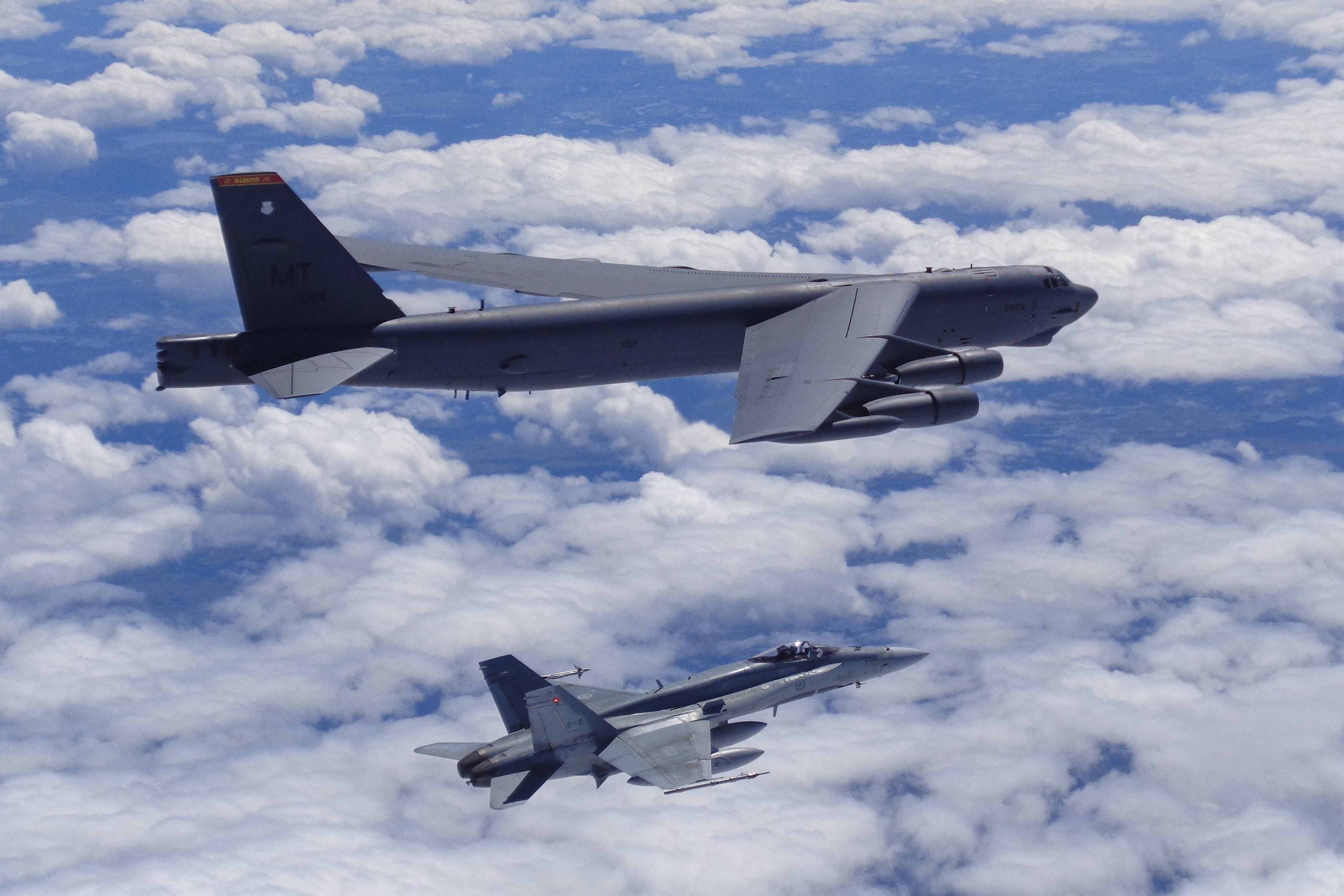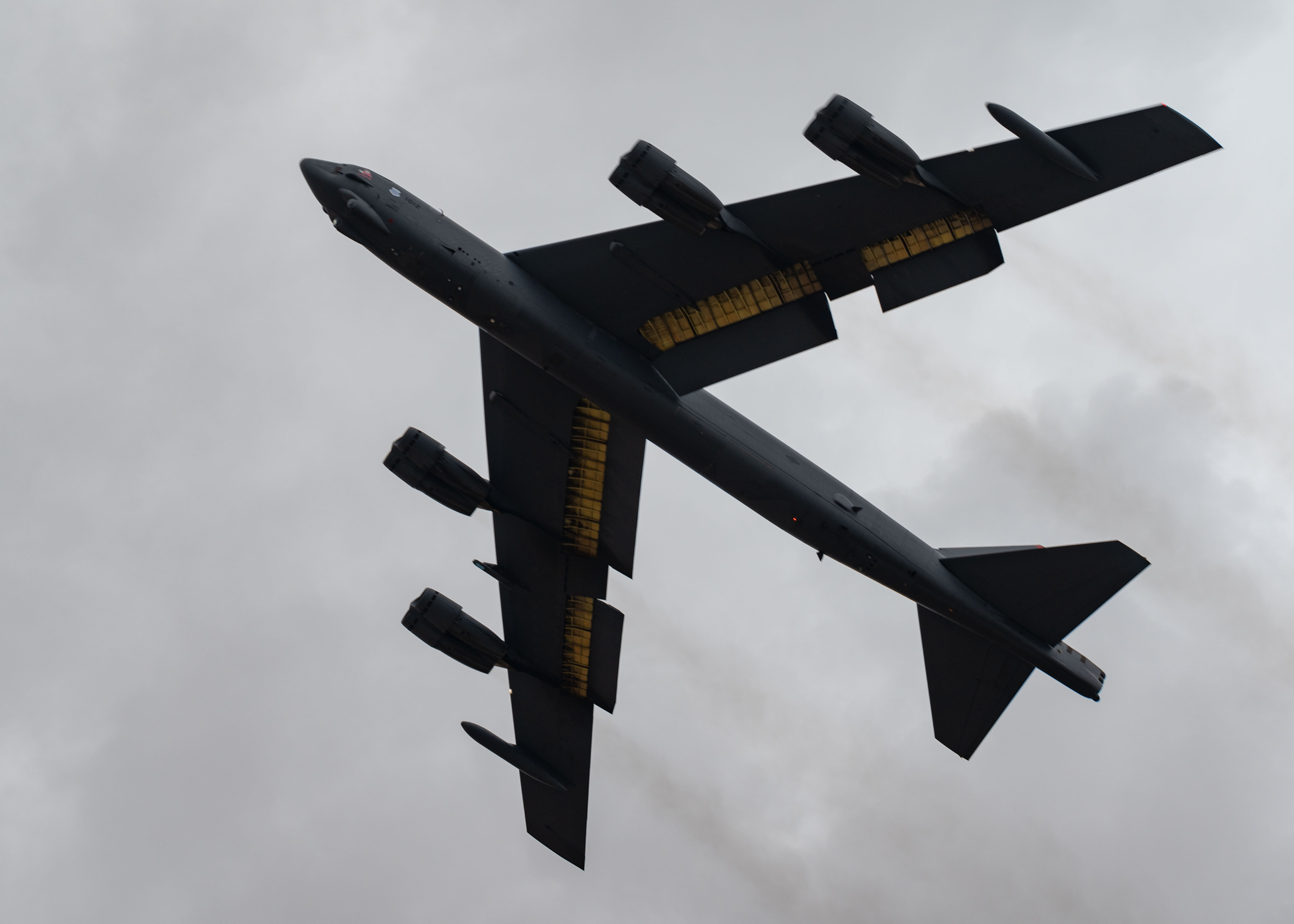2nd Bomb Wing - Size of this preview: 800 × 480 pixels. Other resolutions: 320 × 192 pixels 1024 × 615 pixels | 1. 280 × 768 pixels | 2,560 × 1,537 pixels | 3682 × 2210 pixels.
English: 2d Bomb Wing - Boeing B-52H-175-BW Stratofortress 61-0036 of the 96th Bomb Squadron, Barksdale Air Force Base, La., flies a sortie on February 1 during exercise Red Flag at Nellis AFB, Nev. The purpose of Exercise Red Flag is to train pilots from the United States, NATO and other allied countries for realistic combat scenarios. This includes the use of live ammunition for bombing practice within the Nevada Test and Training Range. (US Air Force photo by Kevin Cox)
2nd Bomb Wing

This image or file is a work of U.S. Air Force pilot or employee, taken or performed as part of that person's official duties. As a work of the US federal government, the image or file is in the US public domain.
Yankee Doodle Ii B 52g 2nd Bomb Wing Aeroplane Apparel Co. Men's T Shi
{{Information |Description ={{da|1=2d Bomb Wing - Boeing B-52H-175-BW Stratofortress 61-0036 of the 96th Bomb Squadron, Barksdale Air Force Base, La., flies a sortie on 1 of February during Exercise Red Flag at Nellis AFB, Nev. The purpose of the exercise Red F...
This file contains additional information such as Exif metadata that may have been added by the digital camera, scanner or software used to create or digitize it. If the file has been modified from its original state, some details, such as the timestamp, may not reflect those in the original file. The time stamp is only as accurate as the clock in the camera, and it can be completely wrong.
A B-52H Stratofortress from the 96th Bomb Squadron, Barksdale Air Force Base, La., flies a sortie Feb. 1 during exercise Red Flag at Nellis AFB, Nev. The purpose of exercise Red Flag is to train pilots from the United States, NATO and other allied countries for realistic combat scenarios. This includes the use of live ammunition for bombing practice within the Nevada Test and Training Range. (U.S. Air Force photo by Kevin Cox)Size of this preview: 610 × 600 pixels. Other resolutions: 244 × 240 pixels 488 × 480 pixels | 781 × 768 pixels | 1042 × 1024 pixels | 2100 × 2064 pixels.
This image of a military insignia could be recreated using vector graphics such as an SVG file. This has several advantages; see: Media for cleaning for more information. If an SVG form of this image is available, upload it and then replace this template with
Ksla Salutes: Barksdale's Newest 2nd Bomb Wing Commander
It is recommended to name the SVG file "2d Bomb Wing.svg" - then the Vector version (or Vva) template does not need the new image name parameter.
Emblem of the 2d Bomb Wing, wing of the United States Air Force (United States Air Force). Motto: Libertatem Defendimus (Freedom We Defend)
Or in fess four air bombs descending bend sinister Azure garnished Argent on a chief engrailed Vert fleur-de-lis White between two pallets Sable, all within a bordure diminished of the first.
Meaning In the form of a Tudor arched shield, the crest is divided into five perpendicular stripes. The colors of the stripes - black and primitive green - are those worn by the Army Air Service during World War I. The three primitive green stripes represent the three major offensives in which the wing participated in World War I: St. Mihiel, Lorraine and Meuse-Argonne. The white ribbon at the top symbolizes France, the theater of operations for the wing's World War I achievements. The lower part of the shield is Air Force Golden Yellow, charged with four aerial bombs in ultramarine blue, representing not only the original four fighter squadrons (11th, 20th, 96th and 166th Aero Squadrons), but also hinting at the the unit's current mission as a heavy bomber wing of the Air Combat Command. Motto: Libertatem Defendimus (Liberty We Defend). The original motto, Mors et Destructio (Death and Destruction), was replaced on 15 April 1940 by the current motto. [1]
Video: Usaf 2nd Bomb Wing B 52s At Raf Fairford (march 2019)
Emblem approved 19 January 1924 for 2nd Bombardment Group; assigned to wing 10 Aug 1951. Emblem changed 25 Apr 1968.
This image depicts a flag, coat of arms, seal, or other official insignia produced by the United States Army Institute of Heraldry. It is in the public domain, but its use is restricted by Title 18, United States Code, Section 704 [2] and the Code of Federal Regulations (32 CFR, Part 507) [3], [4]. Permission to use these images in the United States for most commercial purposes must be obtained from The Institute of Heraldry prior to their use.
This image shows a flag, coat of arms, seal or other official insignia. The use of such symbols is restricted in many countries. These restrictions are independent of copyright status.
This file contains additional information such as Exif metadata that may have been added by the digital camera, scanner or software used to create or digitize it. If the file has been modified from its original state, some details, such as the timestamp, may not reflect those in the original file. The timestamp is only as accurate as the clock in the camera, and it can be completely wrong."2nd Wing" redirects here. For a second Bombardmt Wing from 1948-1991 and a second Wing from 1991-1993, see second Bomb Wing.
B 1b #85 0080 Is Now Retired To Barksdale Global Power Museum
Of the United States Army Air Forces (United States Army Air Forces) is a disbanded unit whose last assignment was with the Continental Air Forces, based at McChord Field, Washington. It was last active in November 1945.
Organized in 1919 at Langley Field, Virginia, the wing assumed control of all Air Service units on the Atlantic coast.
It was inactivated at Langley in 1921 and most of its personnel were assigned to Air Park No.3.
As the second wing, the unit became one of the original wings of GHQ Air Force on 1 March 1935. It again conducted much of the pursuit, bombing and observation operations of the US Army in the eastern United States. The wing's 2nd Bombardmt Group was the first Air Force group to equip the Boeing B-17 Flying Fortress.
F Lc363 1100
The wing provided frameworks for new tactical units activated as the Air Force expanded under the Woodring Plan.
The group was reactivated as a heavy bomber operational command and control organization in June 1942. It moved to the Gland, August–September 1942, and became a heavy bombing wing of the Eighth AF. In the fall of 1942, it helped train bombing groups assigned to Twelfth Air Force.
It served in combat in the European theater from November 1942 to June 1943. The wing temporarily ceased combat in July and August 1943 while its groups were detached to the Mediterranean theater.
The wing resumed combat in the European theater in October 1943 and continued operations until April 1945. In August 1945 it returned to the United States and was inactivated in November.
Barksdale's Air Force Base 2nd Bomb Wing Bombers Arrive At Minot Air Force Base
Chicken wing 1st and 2nd joint, 2nd mortgage, red wing 2nd factory, 2nd dwi, 1st and 2nd wing sections, 2nd marine aircraft wing band, 2nd lien, 2nd dui, 2nd morgage, 2nd marine aircraft wing, 2nd harvest, 2nd marine air wing


0 Comments